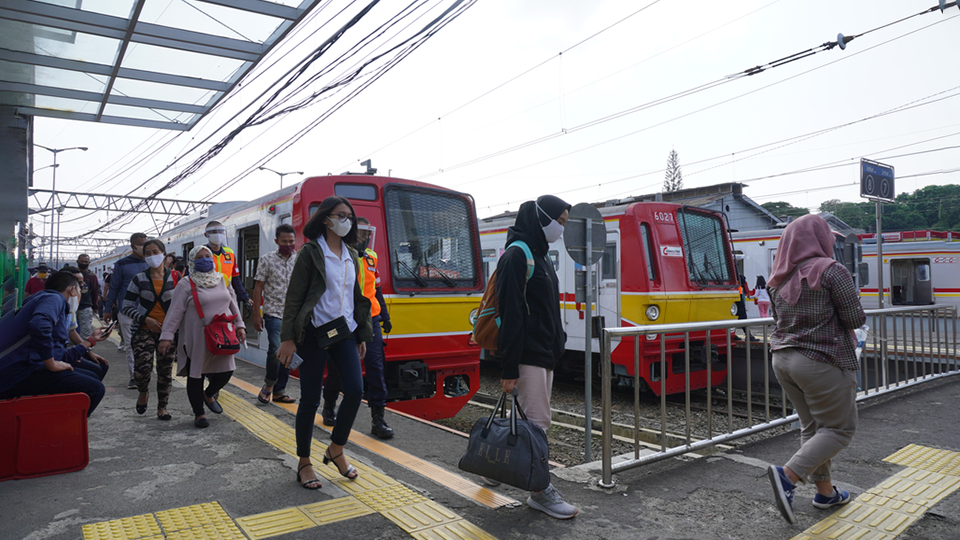
The COVID-19 pandemic has amplified the need for real-time, practical, and reliable data for city governments. Without information on what people are experiencing on the ground, governments do not know how best to respond—they do not know what services are needed, who needs them, and where those people are. Data-driven decisions are critical to not only inform the crisis response, but to help plan the recovery process in the economy, public health infrastructure, and more generally, sustainable development across the region. At the frontline of the COVID-19 response, cities in Indonesia have embraced the need for agile digital data platforms so they can quickly provide support to citizens as the pandemic rages on.
In Indonesia, the COVID-19 virus has progressed fast within communities. The Government of Indonesia (GOI) announced its first positive COVID-19 case in early March, eight weeks after the epidemic first became known. As of September 28, 2020, Indonesia has identified more than 275,000 COVID-19 positive cases and reported more than 10,000 deaths (the highest among the neighboring countries). High population density provinces and urban areas such as DKI (Special Capital Region) Jakarta, other provinces in Java, and metropolitan areas are most affected, but the pandemic is also expected to impact remote regions, which are even more vulnerable owing to underlying disadvantages such as weaker health system capacity.
Limited spatial and temporal information on COVID-19 cases at the community level and barriers to service access makes effective and grounded government response difficult. Reporting compliance is an issue, especially when facility and community-level requirements vary across responsible line departments and information requirements are duplicated. Largely paper-based data collection adds to the complexity of accurately digitizing and rapidly analyzing information. This results in loss of valuable time on monitoring and responding to the socio-economic impacts on local communities. The need for social-distancing measures brought on by COVID-19 has further made traditional data collection mechanisms sub-optimal. Local governments are increasingly turning to virtual data collection, but often lack the capacity to seamlessly manage and analyze it rapidly.
This is where Siap Tanggap (or simply SIAP), which means “Ready to Respond” in Bahasa Indonesia, comes in. SIAP is a new open source, online tool that strengthens geocoded local data collection, management, and analysis to help communities, local and national governments understand the socio-economic impacts of COVID-19 and accelerate recovery. Developed originally as a module of an urban planning tool (CollabData) with the support of the World Bank’s Data Innovation Fund, SIAP offers an opportunity for gathering real-time information, which is key to unlocking regional development strategies and is effectively tailored to capture community needs. It also allows for effective targeting. In Indonesia, SIAP is being applied to perform customizable urban community impact monitoring on a responsive digital platform for collecting and analyzing data directly from communities. This one-stop-shop solution allows citizens to report the support they require to weather the pandemic and ensures that city governments can respond in line with national regulations. While the tool allows data to be collected at individual or household levels, the results are presented in an aggregate (tabular or geospatial formats) to protect respondents’ right to privacy while allowing digital data collection, saving much-needed time and money. Participation from local communities gives a more enriched, comprehensive view of the reality on the ground, allowing for a more nuanced response. In addition, spatial visualizations and analyses can help with prioritization of interventions. The end result: bringing communities and governments closer.
The first application of the SIAP platform was piloted in Semarang City in June 2020. Deployment of the tool was simple, as the SIAP uses a familiar platform to reach respondents and send reminders. While an ‘app version’ of the tool is available, the government chose to send the questionnaire links through the widely used WhatsApp application in Indonesia. The instruction to participate in the survey was disseminated via a chain of WhatsApp groups from Kecamatan heads (district level) to the respondents—neighborhood heads. Within a week, about 7,800 users were registered (nearly 80% of the neighborhoods/sub-wards in Semarang) and logging multiple data streams. In just a few days, more than 4,600 data points were collected.
The questionnaire asked simple multiple-choice questions like “are food supplies sufficient?” and asked respondents to pinpoint their location on a map to record geolocated data and to consent to sharing their location. In return, the government was able to target public policies to specific zones. SIAP can also administer short surveys to remotely monitor public health—a boon for both citizens and governments for whom travel is limited during the pandemic.
During this first week of deployment in Semarang, the data reported 291 individuals with mild symptoms of COVID-19, 63 suffering severe symptoms, and 31 dead. Two wards signaled the highest per capita rate of weekly infections—critical intelligence for targeting public health resources. Semarang officials’ concerns about increased infections due to heightened mobility close during the religious holiday period were validated. Communities reported that 5,042 people had left Semarang city since March 2020, while nearly 2,960 people arrived there in the month previous to the survey. Many did not self-quarantine following travel or report their arrival to the authorities, highlighting the weakness in containment policies and inadequacy of quarantine facilities that led to more targeted local government action as the epidemic progressed.
Meanwhile, the data pointed out that households in one Kelurahan (ward) experienced the highest rates of income cuts in the forms of job layoffs and informal job loss. The survey also offered valuable insights into COVID-related food insecurity issues, pointing to limited funds and price inflation as the most widespread factors in difficulty putting food on the table in six wards. 48 out of 177 (27%) reported more than a quarter of their households facing food shortages, enabling targeted intervention. SIAP data showed disparities with the official Market Price Survey done by the local government, triggering a closer government review.
All this information and more—including data on access to sanitation facilities, unemployment benefits and social assistance, and ability to self-quarantine—has served to inform public policies. Seeing the usefulness of the data coming in through city-wide data collection from all neighborhoods, the City Planning Agency (BAPPEDA) went on to link the data with other government databases (e.g., social assistance, food prices etc.), boosting the power of their COVID-19 response. The city level piloting of the SIAP platform was paired simultaneously with agile updates to the system that were pushed out early to address technical issues of field deployment, demonstrating the resilience of the platform and the importance of including extensive user experience. Following the pilot’s success, Semarang is institutionalizing the platform as an all-purpose data collection and management tool to strengthen government-citizen engagement and accountability in anticipation of a protracted ‘new normal’. The project proved that digital, longitudinal, city-wide grassroots data collection is not only possible and useful, but also incredibly successful.
The success of the city pilot caught the attention of the Ministry of Home Affairs (MOHA). MOHA has requested technical assistance for capacity building to utilize the tool as part of its data-driven response to a COVID-19 exit strategy. The Ministry aims to scale up the deployment of this platform to collect and analyze data from all cities and regencies in Indonesia as part of their data-driven ‘exit strategy’ policy. Easily aggregating and integrating locally collected data, government officials can quickly and easily prioritize within available resources, match requirements with national budgeting and strengthen access to essential public services where they are needed most. Then they can capture the effectiveness of those services periodically though the real-time evaluations of citizens. If successful, the scale-up will help the government design a regional outlook for development planning and offer a powerful tool to bring different levels of government together as the country moves towards COVID-19 recovery.
This project was funded under the World Bank’s Data Innovation Fund, a window of the Trust Fund for Statistical Capacity Building III (TFSCB-III). The TFSCB-III is supported by the United Kingdom’s Foreign, Commonwealth & Development Office, the Department of Foreign Affairs and Trade of Ireland, and the Governments of Canada and Korea.







Join the Conversation